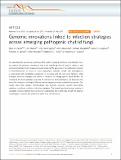| dc.contributor.author | Martel, An | |
| dc.contributor.author | Verbrugghe, Elin | |
| dc.contributor.author | Ducatelle, Richard | |
| dc.contributor.author | Longcore, Joyce E. | |
| dc.contributor.author | James, Timothy Y. | |
| dc.contributor.author | Pasmans, Frank | |
| dc.contributor.author | Fisher, Matthew C. | |
| dc.contributor.author | Farrer, Rhys | |
| dc.contributor.author | Abouelleil, Amr M | |
| dc.contributor.author | Cuomo, Christina A | |
| dc.date.accessioned | 2017-06-21T14:12:45Z | |
| dc.date.available | 2017-06-21T14:12:45Z | |
| dc.date.issued | 2017-03 | |
| dc.date.submitted | 2016-07 | |
| dc.identifier.issn | 2041-1723 | |
| dc.identifier.uri | http://hdl.handle.net/1721.1/110107 | |
| dc.description.abstract | To understand the evolutionary pathways that lead to emerging infections of vertebrates, here we explore the genomic innovations that allow free-living chytrid fungi to adapt to and colonize amphibian hosts. Sequencing and comparing the genomes of two pathogenic species of Batrachochytrium to those of close saprophytic relatives reveals that pathogenicity is associated with remarkable expansions of protease and cell wall gene families, while divergent infection strategies are linked to radiations of lineage-specific gene families. By comparing the host–pathogen response to infection for both pathogens, we illuminate the traits that underpin a strikingly different immune response within a shared host species. Our results show that, despite commonalities that promote infection, specific gene-family radiations contribute to distinct infection strategies. The breadth and evolutionary novelty of candidate virulence factors that we discover underscores the urgent need to halt the advance of pathogenic chytrids and prevent incipient loss of biodiversity. | en_US |
| dc.description.sponsorship | National Human Genome Research Institute (U.S.) (U54HG003067) | en_US |
| dc.language.iso | en_US | |
| dc.publisher | Nature Publishing Group | en_US |
| dc.relation.isversionof | http://dx.doi.org/10.1038/ncomms14742 | en_US |
| dc.rights | Creative Commons Attribution 4.0 International License | en_US |
| dc.rights.uri | http://creativecommons.org/licenses/by/4.0/ | en_US |
| dc.source | Nature | en_US |
| dc.title | Genomic innovations linked to infection strategies across emerging pathogenic chytrid fungi | en_US |
| dc.type | Article | en_US |
| dc.identifier.citation | Farrer, Rhys A.; Martel, An; Verbrugghe, Elin; Abouelleil, Amr; Ducatelle, Richard; Longcore, Joyce E.; James, Timothy Y.; Pasmans, Frank; Fisher, Matthew C. and Cuomo, Christina A. “Genomic Innovations Linked to Infection Strategies Across Emerging Pathogenic Chytrid Fungi.” Nature Communications 8 (March 2017): 14742 © 2017 The Authors | en_US |
| dc.contributor.department | Broad Institute of MIT and Harvard | en_US |
| dc.contributor.mitauthor | Farrer, Rhys | |
| dc.contributor.mitauthor | Abouelleil, Amr M | |
| dc.contributor.mitauthor | Cuomo, Christina A | |
| dc.relation.journal | Nature Communications | en_US |
| dc.eprint.version | Final published version | en_US |
| dc.type.uri | http://purl.org/eprint/type/JournalArticle | en_US |
| eprint.status | http://purl.org/eprint/status/PeerReviewed | en_US |
| dspace.orderedauthors | Farrer, Rhys A.; Martel, An; Verbrugghe, Elin; Abouelleil, Amr; Ducatelle, Richard; Longcore, Joyce E.; James, Timothy Y.; Pasmans, Frank; Fisher, Matthew C.; Cuomo, Christina A. | en_US |
| dspace.embargo.terms | N | en_US |
| dc.identifier.orcid | https://orcid.org/0000-0002-3710-9881 | |
| mit.license | PUBLISHER_CC | en_US |
| mit.metadata.status | Complete | |
